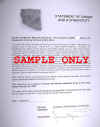|
- Dhofar 019, Oman
- Found January 24, 2000
- Martian meteorite (basaltic shergottite)
A brownish gray stone weighing 1056 grams was found in Dhofar region,
Oman. Mineralogy and classification (M. Nazarov and M. Ivanova of Vernadsky Institute, and
L.A. Taylor of University of Tennessee): fusion crust absent; meteorite is a doleritic
rock consisting of subhedral grains (0.2 - 0.5 mm) of pigeonite (Wo[9-15] En[40-70], Fe/Mn
= 20-40 at.), augite (Wo[30-40] En[40-55]), olivine (Fo[25-60], Fe/Mn = 50-60 at.), and
feldspar (An[36-68]) converted to maskelynite; olivine has higher Fe/Mg than that of
coexisting pyroxenes, as it is in nakhlites; mineralogical modes are approx. 65% pyroxene,
25% maskelynite, and 10% olivine; accessories are silca, K-rich feldspar, whitlockite,
chlorapatite, chromite, ilemnite, titanomagnetite, magnetite, and pyrrhotite; secondary
phases are calcite, gypsum, smectite, celestite, and Fe hydroxides; shock features include
fracturing and mosaicism, maskelynite, and rare impact melt pockets; extensive terrestrial
weathering present mainly as carbonate veins crosscutting the meteorite; however there are
smectite-calcite-gypsum "orangettes" replacing maskelynite, which are similar to
those in ALH84001 and could be of martian origin; in bulk chemistry the meteorite is close
to Shergotty; light rare earth elements are strongly depleted. Specimens: type specimens
of 113 grams, 4 grams, and 2 grams, and two thin sections, Vernadsky Institute; main
mass'with anonymous finder.
|
Specimens available for sale are listed
below.
Click on images to enlarge:
Each specimen comes complete with a photographic
identifier certificate of authenticity, Identification card, and comes packaged in a
plastic display box which suspends the specimen between two membranes. |


